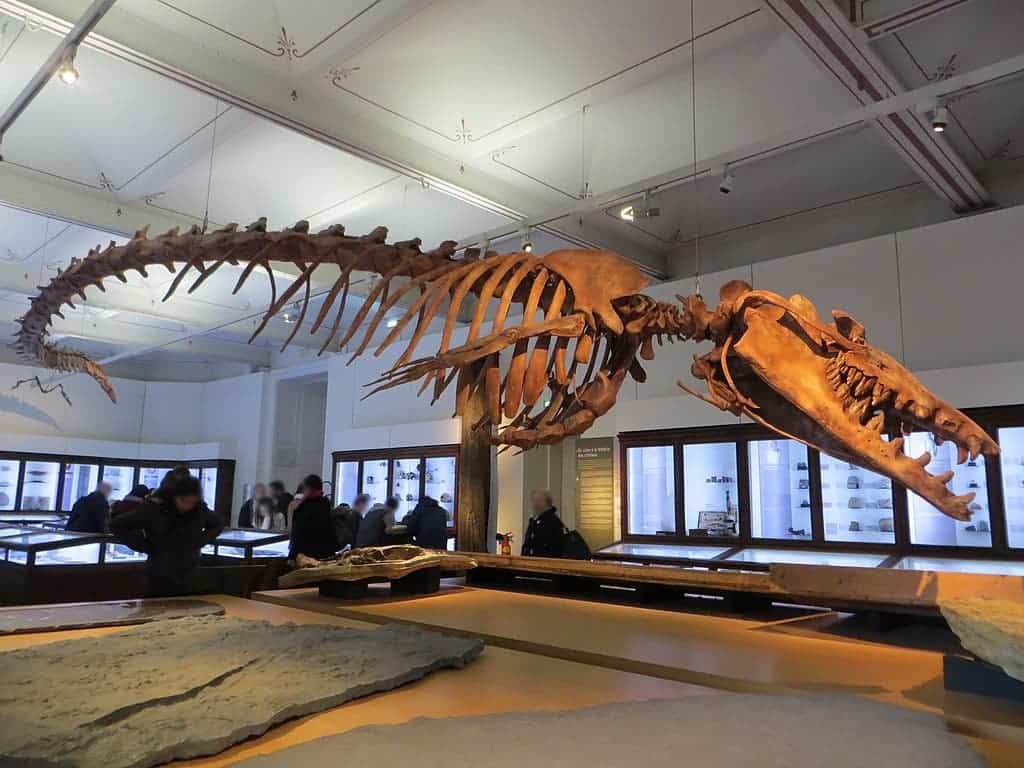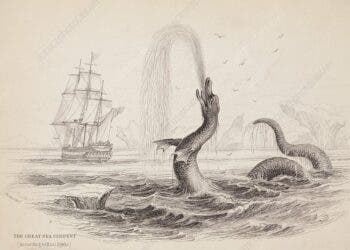Basilosaurus is a storied animal. Scientists initially considered it to be a dinosaur, but we know it’s actually a whale. But the name is still very misleading.
Basilosaurus means ‘king lizard’, and although technically incorrect, the name is still used. At the very least, there’s one reason why the name is deserved: during its day, the Basilosaurus ruled the Tethys Sea with an iron flipper — and a really impressive set of teeth. Let’s see what makes this creature so special.

Basilosaurus size and appearance
Basilosaurus, once believed to be a “king lizard” (the term “saurus” typically refers to lizards or reptiles), is actually an ancient genus of early whales that lived around 40 to 34 million years. Basilosaurus lived a part of geologic time known as the late Eocene. The dinosaurs were quite well gone by this time, and mammals were well on the way to dominating the planet.
The Basilosaurus was also a mammal — a whale, no less — and could grow up to 60 feet (a bit over 18m) in length. This made it one of the most fearsome predators of its time. Researchers believe it was an apex predator and more or less had nothing to fear in the ocean. Its long, serpentine body comprised an elongated vertebral column and a reduced ribcage, granting it a unique and slender form that set it apart from modern whales.
The skull of Basilosaurus was elongated and equipped with robust jaws filled with conical teeth, capable of tackling large prey. Its rear limbs were tiny and nonfunctional, while the forelimbs were larger and flipper-like. Unlike modern whales, it lacked the melon organ, a fat-filled organ in the forehead that helps in echolocation.
Understanding Basilosaurus
The academic story of this genus starts with B. cetoides, the first ancient whale species ever discovered. This basilosaurus was unearthed in Louisiana around 1830 by Richard Harlan and still serves as the type species of Basilosaurus.
The first Basilosaurus fossil was described in 1834 from fragments of a skeleton found in the US. The fossils were huge and they were very similar to marine predatory dinosaurs. Due to insufficient paleontological evidence and the limits of paleontological understanding of the day, the species was initially assumed to have been a dinosaur — and christened the ‘king of the lizards’, Basilosaurus.
But this wasn’t the last word on Basilosaurus.
Comparing the bones he received to those of Plesiosaurus and Mosasaurus, two species of marine dinosaurs that were already described at the time, naturalists at the time concluded that the new species grew no less than 80–100 ft (24–30 m) long.
But what really stood out to them is that the vertebras of Basilosaurus were apparently similar to those of Plesiosaurus, a genus of extinct, large marine reptile. The skull of Basilosaurus was similar to that of Mosasaurus. It seemed to make sense that Basilosaurus was also a lizard.
The first signs that this name wasn’t really spot-on came when Richard Owen, a controversial figure but an enormously talented paleontologist, observed that the animal’s molars were two-rooted. No known fish or reptile at the time showed the same structure, and Owen suggested the animal might have been a whale instead. The two even agreed to rename it Zeuglodon cetoides (“whale-like yoke teeth”).
A few years later the other known species, B. isis, would be described based on fragments of bone recovered from Egypt. Although the first full skeleton of B. isis wouldn’t be unearthed until 2016, the discovery of this species and its fossil association with species that were known to have been whales at the time further suggested that all Basilodons were, in fact, mammals. This was helped by the fact that Basilosaurus fossils actually became quite common over time, so much so that in the 19th century they were even used as andirons, furniture, or decoration.
Over the years, paleontologists have wisened up to the fact and tried to change the genus’ name. However, zoological naming conventions meant that the original name stuck. Today, the Basilosaurus is the state fossil for Alabama and Mississippi.
How did Basilosaurus live?
One thing that Harlan got right about the Basilosaurus was that it was large. This whale was bigger even than some predatory dinosaurs that came before it, and it undoubtedly threw its weight around the ancient, lost sea of Tethys.
Another thing it definitely threw around was bites. Unlike most whales today, Basilosaurus didn’t filter feed, it hunted. Yep, Basilosaurus was no getle giant — it was a hunter. Its jaws were lined with several types of teeth, including molars and canines, which are specialized for chewing and ripping, respectively. Such teeth are characteristic of meat-eating species.
Two other important characteristics of the species are skull asymmetry and a relatively low intracranial volume. The first is a trait it shares with modern toothed whales such as orcas. Today, this asymmetry is associated with whales’ ability to produce high-frequency sounds for echolocation. Basilosaurus likely didn’t have this ability, however, and its skull was asymmetrical in order to house a fatty sensory organ meant to help it hear underwater.
The lack of room for a big brain inside its skull likely means that Basilosaurus was not a social species, like whales are today, and that it also wasn’t as capable from a cognitive standpoint. So it was likely a solitary hunter, especially as it wouldn’t have needed too much help to catch prey.
But all these evolutionary traits point at a ‘work-in-progress’ creature. The Basilosaurus seems to have been the first whale species to live entirely underwater, marking the point where the lineage of walking whales finally took the plunge. It makes sense, as during the late Eocene, many of the creatures we see today on Earth started developing.
Brawns over brains
It most likely spent its day as a solitary hunter, or at most, one that lived in small groups. Social interactions are extremely demanding, from a cognitive point of view, and Basilosaurus’ brain just seems to have been too small to adequately navigate living in a group.
But who needs big brains when you have big brawns? Analysis of fossilized, scarred Dorudon skull bones — this is another genus of prehistoric whale that was the preferred prey of Basilosaurus — suggests that the king of lizards could bite down with 3,600 pounds per square inch (PSI). To put things into perspective, that’s 233 times more pressure than a fully-loaded M1A2 main battle tank exerts on the ground under its tracks. Most industrial hydraulic presses in use today exert between 1,000 to 3,000 PSI, which is still under the estimated high of Basilosaurus. You do not want to get bitten by one of these.
No creature in the ocean would be spared the terror of Basilosaurus. If it wanted to hunt you, the odds are it could.
With big bites, however, also comes good manners. Wear patterns on Basilosaurus teeth suggest that the animal bit and then chewed its food. This is different from most predators today. Many predators nowadays have teeth that are specialized in ripping chunks of meat off the bone. These pieces are then gulped up whole.
In regards to what they ate, stomach contents seem to indicate that B. cetoides hunted fish and large sharks exclusively, while we know from Dorudon skulls that B. isis would also hunt these. Dorudon was a larger animal, related to today’s dolphins, and B. isis likely focused on delivering a killing blow to its head before tearing it apart while feeding (many Dorudon skeletons, especially those showing signs of predation from Basilosaurus, are found disarticulated).
King no more
The Basilosaur genus went extinct, with our last fossil evidence of them hailing from around 40 million years ago. They didn’t leave behind any direct descendants which, judging from their teeth, isn’t the worst thing to have ever happened.
We’re not entirely sure why they disappeared. Sometime around 40 million years ago, something happened to bring these toothy kings low. However, the fact that other toothed and baleen whales are around today suggests these smaller relatives of the Basilosaurus out-competed them in the end. It might have been their big brains, it might have been their social nature. It could even have been their more modest appetites; for now, it remains a mystery.
Basilosaurus FAQ
Basilosaurus is a prehistoric marine mammal that belonged to the group of ancient whales known as archaeocetes. Despite its name, which means “king lizard,” it is not a reptile but a type of early whale.
Basilosaurus could probably grow up to 60 feet (18 meters) long, making it one of the largest animals of its time. Its elongated body resembled that of a sea serpent.
Basilosaurus was a carnivore, and its diet likely consisted of smaller marine mammals and large fish. Its sharp teeth and strong jaws indicate that it was a formidable predator.
Fossils of Basilosaurus have been found in North America, Northern Africa, and Western Asia, indicating that it inhabited the warm, shallow seas of the Tethys Ocean during the Late Eocene epoch.
No, Basilosaurus is not a dinosaur. The name is misleading and stems from a misunderstanding when the first fossil was discovered. It was initially thought to be a reptile, hence the name, but later found to be a whale.
Basilosaurus’s body was elongated, and its hind limbs were tiny and non-functional for locomotion. It likely moved by undulating its body and tail, much like modern eels.
Basilosaurus went extinct around 34 million years ago, likely due to changes in climate and environment. The disappearance of Basilosaurus is part of a broader pattern of extinction that affected many marine species at the end of the Eocene epoch.
Yes, several museums around the world have Basilosaurus specimens or replicas on display. Some prominent locations include the Smithsonian National Museum of Natural History in Washington, D.C., and the Field Museum in Chicago.
Basilosaurus provides critical insights into the evolutionary transition of whales from land-dwelling creatures to fully marine mammals. It represents a stage in the evolutionary process where features of both primitive and modern whales can be seen.
While Basilosaurus was indeed one of the largest animals of its time, other marine creatures might have reached similar sizes. Its sheer size and predatory nature certainly make Basilosaurus one of the more remarkable creatures of the Eocene era.
Basilosaurus lived in warm, shallow seas and coastal areas. Its habitat would have been rich in marine life, providing ample opportunities for hunting.
Yes, Basilosaurus lived alongside a variety of other early whale species, as well as sharks, rays, sea turtles, and various types of fish.






